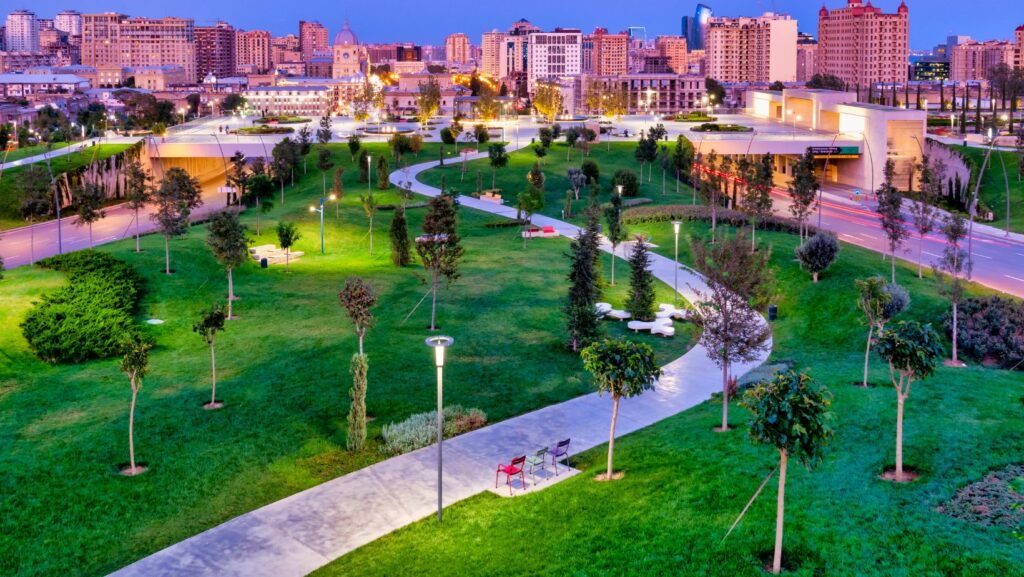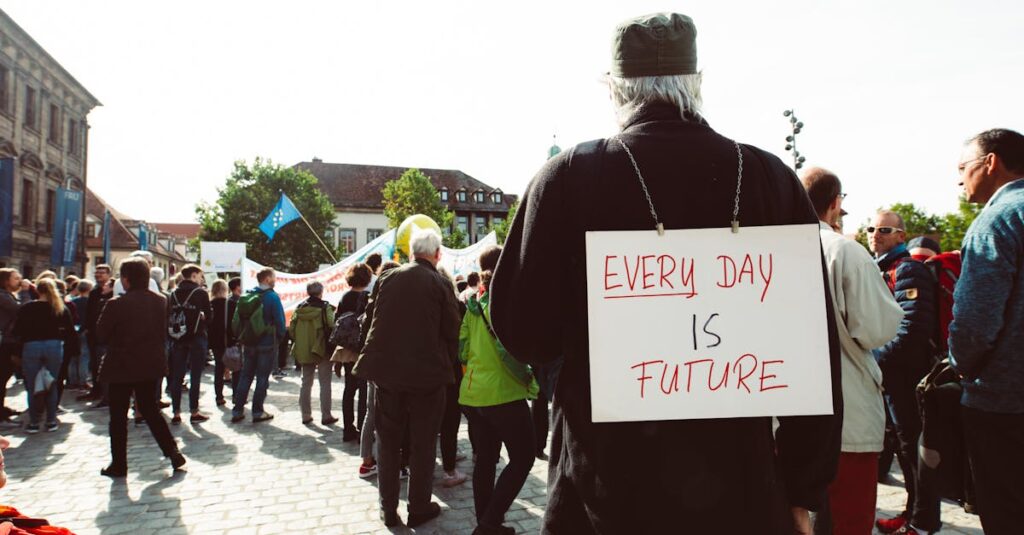Urban green spaces transform concrete jungles into vibrant oases where city dwellers can escape the daily grind. From pocket parks tucked between buildings to sprawling botanical gardens these green havens provide essential breathing room in densely packed metropolitan areas.
Today’s cities showcase innovative approaches to incorporating nature into urban planning. Whether it’s New York’s High Line – an elevated park built on abandoned railway tracks – or Singapore’s Gardens by the Bay with its futuristic Supertrees cities worldwide are finding creative ways to weave greenery into their fabric. These spaces don’t just look pretty; they’re working overtime to improve air quality boost mental health and create community gathering spots.
Urban Green Spaces Examples
Urban green spaces examples encompass designated areas within cities that feature natural elements. These spaces integrate vegetation, water features, paths, and recreational facilities into the urban landscape.
Key Features and Benefits
Urban green spaces incorporate distinct characteristics that enhance city living:
Natural Elements
- Trees provide shade coverage for temperature regulation
- Native plants support local biodiversity
- Gardens offer food production opportunities through community plots
- Water features create cooling effects for surrounding areas
Infrastructure Components
- Walking paths connect different sections of the space
- Benches and seating areas encourage social interaction
- Playgrounds serve families with children
- Exercise stations promote physical activity
Environmental Impact
- Green spaces filter air pollutants
- Permeable surfaces manage stormwater runoff
- Plant life reduces urban heat island effects
- Natural habitats support wildlife populations
- Open areas host community events gatherings
- Quiet zones enable meditation relaxation
- Sports fields facilitate organized activities
- Educational spaces support nature programs
- Access reduces stress levels
- Outdoor recreation improves physical fitness
- Natural settings enhance mental wellbeing
- Green views speed recovery rates
Urban Parks and Gardens
Urban green spaces examples parks and gardens represent the cornerstone of green infrastructure in metropolitan areas. These spaces transform concrete landscapes into vibrant community hubs that support recreation wellness activities.
Central Park, New York City
Central Park spans 843 acres in the heart of Manhattan offering diverse recreational opportunities. The park features 58 miles of pedestrian paths 7 water bodies 21 playgrounds numerous sports facilities including 26 baseball fields. Frederick Law Olmsted’s 1858 design integrates natural landscapes with architectural elements such as Belvedere Castle Bethesda Fountain Bow Bridge. The park’s zones include the Great Lawn for concerts picnics the Conservatory Garden for formal horticulture displays the Central Park Zoo for wildlife education.
High Line Park, Manhattan
The High Line Park transformed an abandoned elevated railway into a 1.45-mile-long elevated green corridor. This innovative park features over 500 species of plants grasses designed by Piet Oudolf. The space includes art installations viewing points gathering areas custom-designed benches that merge with plantings. Distinct sections showcase different microenvironments including grasslands woodlands wetland areas. The park attracts 8 million visitors annually supports local biodiversity with native plant species provides spaces for outdoor performances cultural events.
Rooftop Gardens and Green Roofs
Rooftop gardens transform unused urban spaces into verdant oases, combining innovative architecture with ecological benefits. These elevated green spaces maximize limited urban real estate while providing environmental advantages including temperature regulation thermal insulation stormwater management.
Singapore’s Skyrise Greenery
Singapore leads global urban greening initiatives with over 200 hectares of rooftop gardens across the city-state. The PARKROYAL Collection Pickering hotel features 15,000 square meters of cascading vertical gardens integrated into its design. Marina Bay Sands SkyPark showcases a 1.2-hectare rooftop garden with 250 tree species 650 meters above ground level. Sustainable features include rainwater harvesting systems solar-powered lighting advanced irrigation technologies that maintain these elevated ecosystems. The Skyrise Greenery Incentive Scheme offers building owners up to 50% funding support to integrate rooftop greenery.
Chicago City Hall Green Roof
Chicago City Hall’s 20,000-square-foot green roof stands as North America’s first municipal green roof installation. The rooftop garden contains 150 plant species including native prairie grasses sedum varieties perennial flowers. Temperature monitoring shows the roof reduces ambient temperatures by 30-40°F compared to neighboring conventional roofs during summer months. The design captures 75% of annual rainfall reducing stormwater runoff into city systems. Motion sensors track wildlife activity documenting 90 bird species 300 invertebrate species utilizing the space. The project serves as a model for urban sustainability inspiring 500+ green roof installations across Chicago totaling 5 million square feet of coverage.
Urban Forests and Woodlands
Urban forests create extensive green corridors that integrate natural ecosystems into city landscapes. These woodland areas provide essential habitats for wildlife while offering recreational opportunities for city residents.
Stockholm’s Royal National City Park
Stockholm’s Royal National City Park stands as the world’s first urban national park, spanning 27 square kilometers across the city. This expansive green space contains ancient oak trees, meadows lakes that support over 1,000 butterfly species 100 bird species. The park connects multiple cultural heritage sites including three royal palaces Haga Park Swedish Museum of Natural History. Local conservation efforts maintain 800-year-old oak trees which serve as critical habitats for rare insects beetles. The park attracts 15 million visitors annually who engage in activities like hiking, cycling birdwatching.
Portland’s Forest Park
Portland’s Forest Park encompasses 5,200 acres of urban forest, making it one of America’s largest urban forests within city limits. The park features 80 miles of trails connecting to the Wildwood Trail system through the Tualatin Mountains. Native wildlife thrives here, including 112 bird species 62 mammal species. Douglas fir Western red cedar dominate the forest canopy, creating a dense ecosystem that filters air pollutants absorbs rainfall. The park’s proximity to downtown Portland provides easy access for 40,000 monthly visitors who utilize its extensive network of hiking running trails.
Community Gardens and Allotments
Community gardens transform vacant urban lots into productive green spaces where residents grow food cultivate relationships with neighbors. These shared spaces promote sustainable food production local biodiversity while creating vibrant community hubs.
Seattle P-Patch Program
Seattle’s P-Patch Program stands as America’s largest municipally-managed community gardening initiative with 90 gardens spanning 32 acres across the city. The program serves 3,000+ urban gardeners who cultivate organic produce in plots ranging from 40 to 400 square feet. P-Patch gardeners donate 25,000+ pounds of fresh produce annually to local food banks through the program’s Giving Garden Network. These gardens feature communal gathering spaces composting facilities water-conservation systems native plant sections that support local pollinators.
Berlin’s Urban Gardens
Berlin hosts 71,000 urban garden plots across 900 allotment gardens covering 3,000 hectares of city space. Prinzessinnengarten in Kreuzberg transforms an abandoned lot into a thriving community garden featuring mobile raised beds portable greenhouses that enable flexible urban agriculture. The Tempelhof Field Community Garden occupies 12 acres of a former airport housing 500 plots managed by local residents. These spaces incorporate innovative designs including rainwater harvesting systems solar-powered irrigation vertical growing structures that maximize limited urban space.
Green Corridors and Linear Parks
Green corridors transform abandoned urban infrastructure into vibrant recreational spaces that connect neighborhoods while promoting biodiversity and sustainable transportation. These linear parks create uninterrupted pathways for pedestrians, cyclists and wildlife throughout metropolitan areas.
Atlanta BeltLine
The Atlanta BeltLine represents a transformative 22-mile circular greenway built along former railway corridors. This comprehensive network connects 45 neighborhoods through multi-use trails, parks and transit options. The project features native plant installations, public art displays and gathering spaces that attract 2 million visitors annually. Construction began in 2006 with the development of several trail segments including the popular Eastside Trail, which spans 3 miles through historic neighborhoods. The BeltLine incorporates 33 miles of multi-use trails, 1,300 acres of parks and generates $4.1 billion in private economic development along its corridor.
Seoul’s Cheonggyecheon Stream
Seoul’s Cheonggyecheon Stream restoration project converted a concrete-covered highway into an 11-kilometer urban waterway and linear park. The transformation replaced elevated roads with a natural stream featuring 22 bridges, waterfalls and indigenous plantings. This urban renewal initiative created 636 acres of new green space in central Seoul while reducing air temperatures by 3.6°C along the corridor. The stream attracts 64,000 daily visitors who enjoy walking paths, cultural spaces and periodic festivals. Biodiversity thrives with 25 fish species, 37 bird species and 248 plant species now inhabiting the restored ecosystem. The project demonstrates how removing urban infrastructure creates opportunities for nature-based solutions that benefit communities.
Future of Urban Living
Urban green spaces examples have proven to be transformative elements in modern city planning. From New York’s iconic Central Park to Singapore’s innovative rooftop gardens these spaces represent more than just patches of greenery. They’re vital components of sustainable urban development that benefit both residents and the environment.
The success stories from cities worldwide demonstrate that investing in green spaces yields remarkable returns for community health urban biodiversity and social cohesion. As cities continue to grow implementing these green solutions isn’t just an option – it’s a necessity for creating livable sustainable urban environments that will thrive for generations to come.



